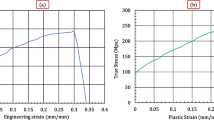Abstract
Profiled power spinning is a complex metal forming process as there are many factors interrelated. The spinnability plays an important role in predicting fracture and controlling the shape of the profiled component. In this paper, a 3D finite element (FE) model is established so as to investigate on the spinnability of the ellipsoidal power spinning. The variation of the equivalent stress and the equivalent plastic strain are analyzed, and the analysis of variance takes comprehensive influence on the spinnability into consideration. The fracture behaviors of the ellipsoidal components are analyzed with the Johnson–Cook fracture criterion. The results show that the equivalent stress and the equivalent plastic strain increase with the forming time. As for the mono-factor influence, the spinnability is improved when the feed rate of the rollers decreases or the friction coefficient increases. As for the multi-factor influence, the interaction between the feed rate and the friction coefficient has a significant effect on the spinnability. The initial fracture is presented in the fillet part between the blank and the mandrel where the equivalent plastic strain reaches the maximum, the stress triaxiality is the minimum, and the Johnson–Cook damage initiation criterion approach one. The simulation results using the Johnson–Cook fracture criterion are in a good agreement with the experimental results during the ellipsoidal power spinning.
Similar content being viewed by others
References
Schubert E, Klassen M, Zerner I, Walz C, Sepold G (2011) Light-weight structures produced by laser beam joining for future applications in automobile and aerospace industry. J Mater Process Technol 115:2–8
Avitzur B, Yang CT (1960) Analysis of power spinning of cones. J Eng Ind 82:231–244
Quigley E, Monaghan J (2000) Metal forming: an analysis of spinning processes. J Mater Process Technol 103:114–119
Music O, Allwood JM, Kawai K (2010) A review of the mechanics of metal spinning. J Mater Process Technol 210:3–23
Bai Q, Yang H, Zhan M (2008) Finite element modeling of power spinning of thin-walled shell with hoop inner rib. Trans Nonferrous Metal Soc 18:6–13
Molladavoudi HR, Djavanroodi F (2011) Experimental study of thickness reduction effects on mechanical properties and spinning accuracy of aluminum 7075-O, during flow forming. Int J Adv Manuf Technol 52:949–957
Kalpakcioglu S (1961) A study of shear-spinnability of metals. J Eng Ind 83:478–483
Wong CC, Dean TA, Lin J (2003) A review of spinning, shear forming and flow forming processes. Int J Mach Tools Manuf 43:1419–1435
Kegg RL (1961) A new test method for determination of spinnability of metals. J Eng Ind 83:119–124
Kalpakcioglu S (1964) Maximum reduction in power spinning of tubes. J Eng Ind 86:49–54
Hayama M, Murota T, Kudo H (1966) Deformation modes and wrinkling of flange on shear spinning. Bull JSME 9:423–433
Chang SC, Huang CA, Yu SY, Chang Y, Han WC, Shieh TS, Chung HC, Yao HT, Shyu GD, Hou HY, Wang CC, Wang WS (1998) Tube spinnability of AA2024 and 7075 aluminum alloys. J Mater Process Technol 80–81:676–682
Podder B, Mondal C, Kumara KR, Yadav DR (2012) Effect of preform heat treatment on the flow formability and mechanical properties of AISI4340 steel. Mater Des 37:174–181
Huang CC, Hung JC, Hung C, Lin CR (2011) Finite element analysis on neck-spinning process of tube at elevated temperature. Int J Adv Manuf Technol 56:1039–1048
Xia Q, Cheng X, Long H, Ruan F (2012) Finite element analysis and experimental investigation on deformation mechanism of non-axisymmetric tube spinning. Int J Adv Manuf Technol 59:263–272
Xu Y, Zhang SH, Li P, Yang K, Shan DB, Lu Y (2001) 3D rigid-plastic FEM numerical simulation of tube spinning. J Mater Process Technol 113:710–713
Parsa MH, Pazooki AMA, Ahmadabadi MN (2009) Flow-forming and flow formability simulation. Int J Adv Manuf Technol 42:463–473
Hauk S, Vazquez VH, Altan T (2000) Finite element simulation of the flow-splitting-process. J Mater Process Technol 98:70–80
Zhang J, Zhan M, Yang H, Jiang Z, Han D (2012) 3D-FE modeling for power spinning of large ellipsoidal heads with variable thicknesses. Comput Mater Sci 53:303–313
Zhang JH, Yang H, Zhan M, Jiang HB (2011) Research on the stress and strain field and wall thickness in power spinning of ellipsoidal heads with variable thickness. Adv Mater Res 189–193:1960–1963
Sun JS, Lee KH, Lee HP (2000) Comparison of implicit and explicit finite element methods for dynamic problems. J Mater Process Technol 105:110–118
Zhan M, Yang H, Zhang JH, Xu YL, Ma F (2007) 3D FEM analysis of influence of roller feed rate of roller on forming force and quality of cone spinning. J Mater Process Technol 187–188:486–491
Adetoro OB, Wen PH (2010) Prediction of mechanistic cutting force coefficients using ALE formulation. Int J Adv Manuf Technol 46:79–90
Johnson GR, Cook WH (1985) Fracture characteristics of three metals subjected to various strains, strain rates, temperatures and pressures. Eng Fract Mech 21:31–48
Huang L, Yang H, Zhan M, Liu Y (2008) Analysis of splitting spinning force by the principal stress method. J Mater Process Technol 201:267–272
Huang L, Zeng R, Zhang X, Li J (2014) Study on plastic deformation behavior of hot splitting spinning of TA15 titanium alloy. Mater Des 58:465–474
Chen MD, Hsu RQ, Fuh KH (2007) An analysis of force distribution in shear spinning of cone. Int J Mech Sci 47:902–921
Low C, Hsu CM, Yu FJ (2003) Analysis of variations in a multi-variate process using neural networks. Int J Adv Manuf Technol 22:911–921
Fazeli AR, Ghoreishi M (2011) Statistical analysis of dimensional changes in thermomechanical tube-spinning process. Int J Adv Manuf Technol 52:597–607
Author information
Authors and Affiliations
Corresponding author
Rights and permissions
About this article
Cite this article
Zeng, R., Ma, F., Huang, L. et al. Investigation on spinnability of profiled power spinning of aluminum alloy. Int J Adv Manuf Technol 80, 535–548 (2015). https://doi.org/10.1007/s00170-015-7025-2
Received:
Accepted:
Published:
Issue Date:
DOI: https://doi.org/10.1007/s00170-015-7025-2



